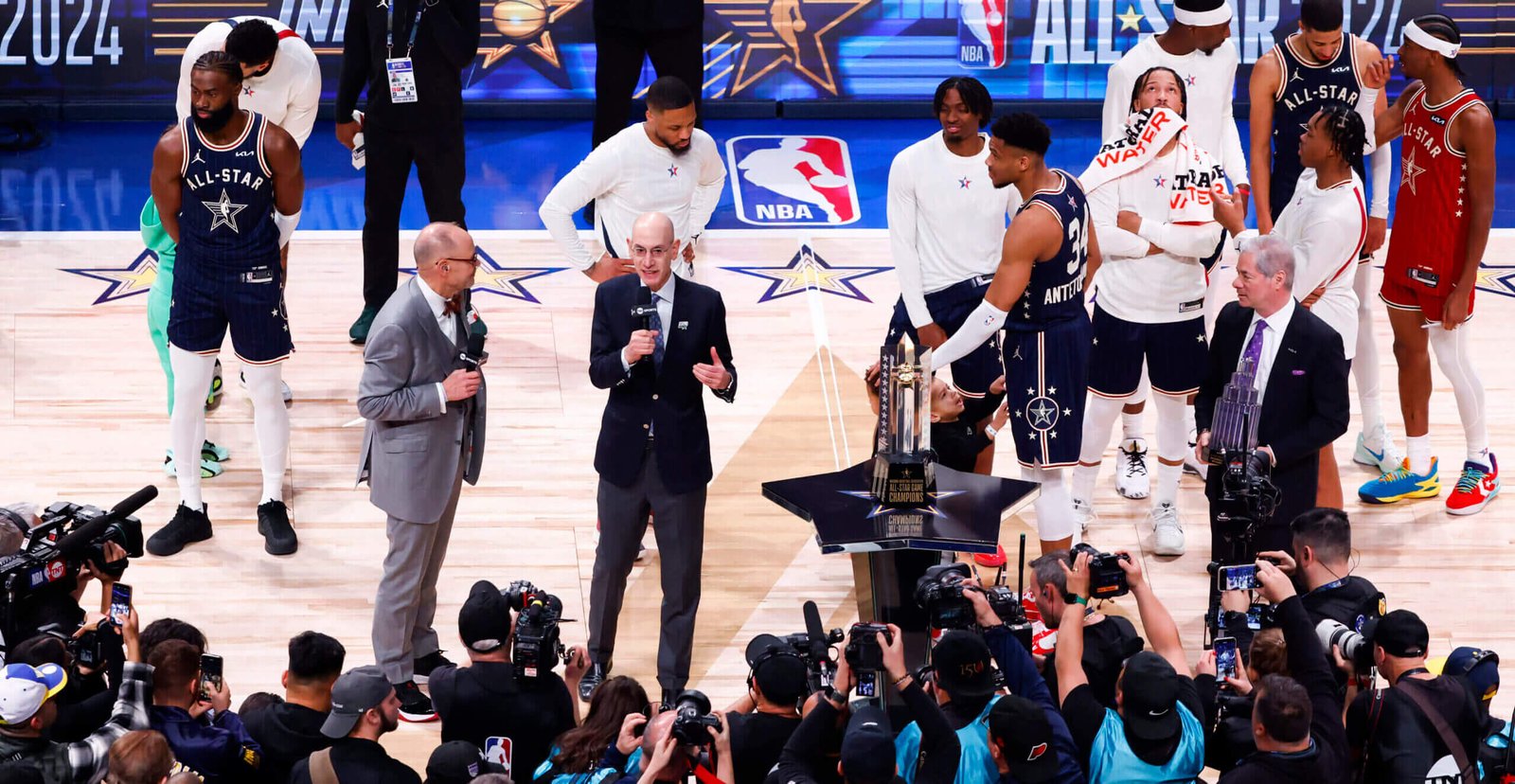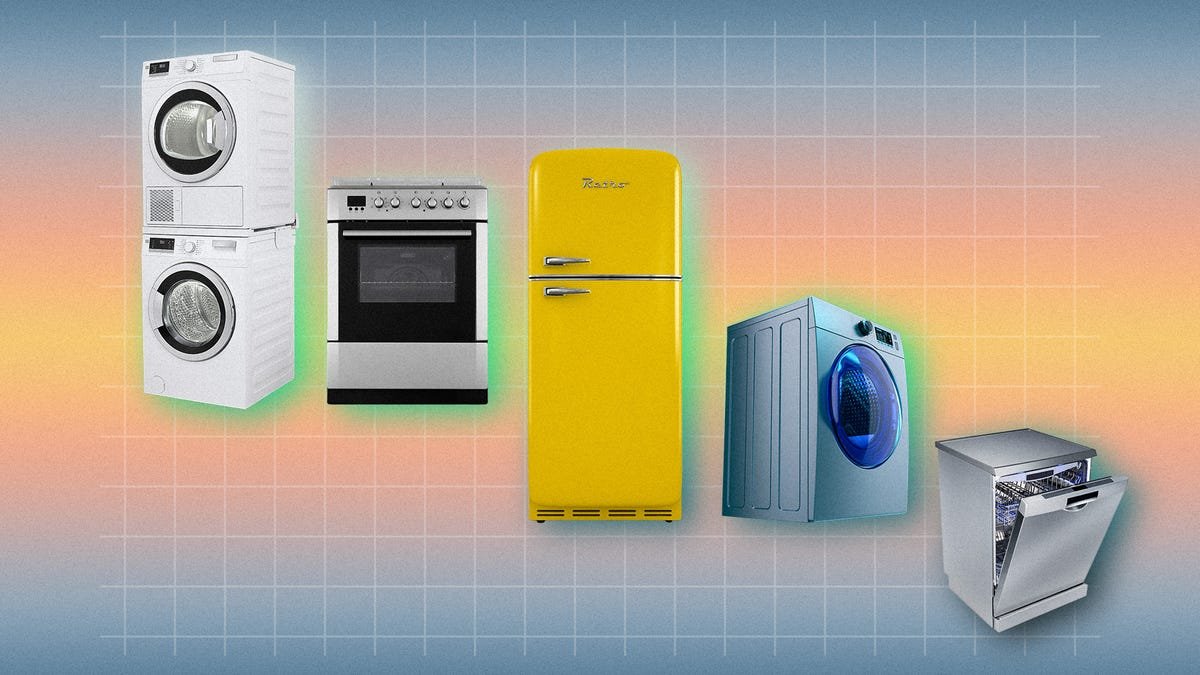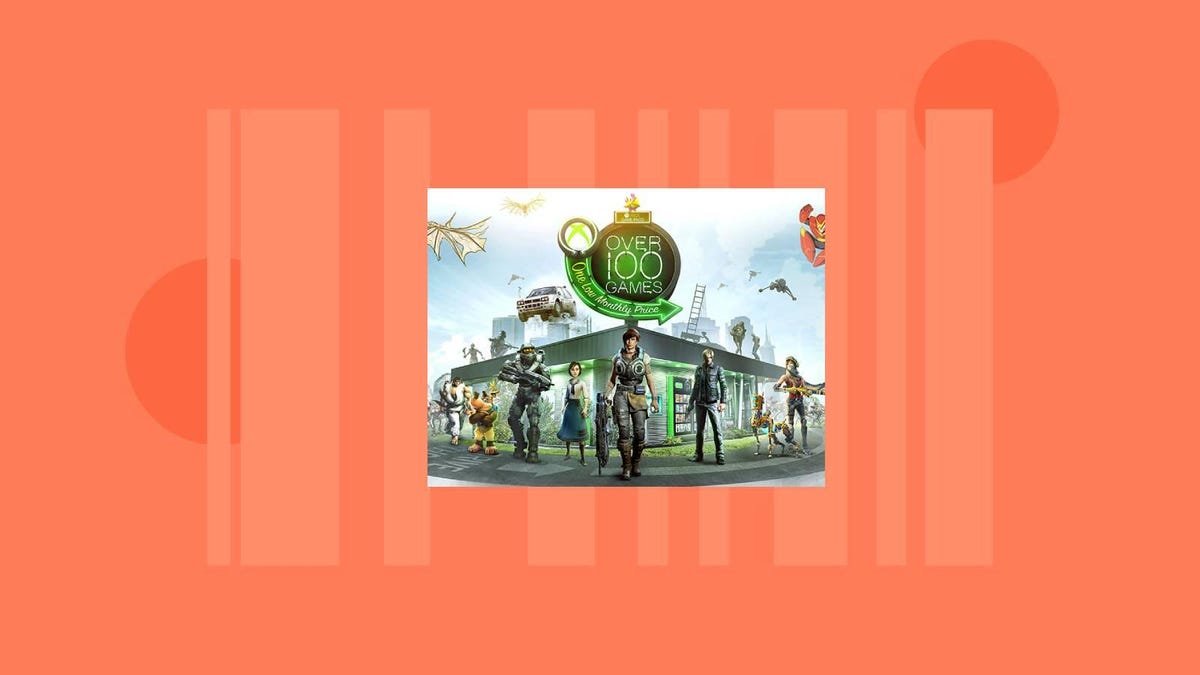
How can the NBA fix the All-Star Game? Our writers share their ideas
[ad_1]
Another NBA All-Star Game has come and gone, and it was once again an uninspiring Sunday night. The game, once the crown jewel of All-Star Weekend, was a dud despite expectations that the league was going to fix it.
NBA commissioner Adam Silver said as much on the eve of the game itself. He discussed the changes the league made to make the game more competitive — welcome back, East vs. West! – the efforts it took to figure it out with the players, all the nuances of the wait times for introductions and halftime. All of it.
“I think we’re going to see a good game tomorrow night,” Silver said.
Then he, and we, got a 211-186 East win. It was the first time in league history that the winning team surpassed 200 points.
The All-Star Game remains unfixed. Now the question turns toward how to actually do that. Can it be done at all? Somebody has to solve the NBA’s All-Star Game malaise. Why not us?
The Athletic asked members of its NBA staff one question: “What can be done to fix the All-Star Game?” Here’s what some of them said:
Joe Vardon, senior writer: Combine the In-Season Tournament (IST) and All-Star Weekend. Expand the IST a little, put a little more money into it (for IST and for All-Star Saturday participants), move the IST back a little so that the final four lands at the actual season’s midpoint, celebrate your All-Stars with a nice little ceremony that weekend, have an All-Star Saturday night in between final four and finals and then the entire league takes a week off.
Mike Vorkunov, NBA/Business of Basketball writer: What if the NBA still picked 12 All-Stars from each conference but eliminated the game and made each of them have to pick one of the All-Star Saturday Night events to compete in? Cancel the game but save the Slam Dunk Contest.
GO DEEPER
Saving the All-Star Game; scouting Donovan Clingan, GG Jackson: Hollinger’s Week That Was
Sam Amick, senior writer: Here’s the problem with the idea of an All-Star Game bonus (bigger than the $100,000 they already get for winning), losers get $25,000, and the comparison to the IST: The $500,000 IST prize is big enough to matter to lower-level players, and we saw All-Stars who make $30 million-plus a year decide to care in large part because their teammates who make so much less had a chance to make impactful cash. But in an All-Star Game, where they all make so much already, what the hell kind of number would it take to have a similar effect on the competitiveness? Seriously, are we talking about an extra $5 million to $10 million per guy? The optics of that would be rough, not to mention counterproductive from a business standpoint for the league. It would be nice if players would just take it seriously for the sake of honoring those who paved the way, but it’s pretty clear that’s not going to happen. And from what I heard after the game, there was no shortage of former players who were rolling their eyes at what they had just watched.
John Hollinger, senior columnist: I’m not sure the money was more than a secondary motivation for the IST. … Games all counted except the last one, and in the final, you’re understood to be playing a game that matters (to your owner/coach/fans/teammates, if not to you). The All-Star Game is just …. an exhibition.
Amick: Fair points, John, but they make the notion of more money being a possible solution even more challenging. And I make these points because, as I wrote overnight, that was the discussion among some of the players after the game (that a big prize would change how they play in the ASG).
Vorkunov: Why is the All-Star Game worth saving? It worked for a number of years, and now it doesn’t. If the NBA is about innovation, then it should try to find a new way to service fans. Maybe move the skills challenge/3-point contest and dunk contests to Sunday and incentivize its biggest stars to actually compete in them. That diminishes the chances of getting hurt (which is ostensibly a reason they don’t try in the ASG now). Replace Saturday night with something else. Or keep Saturday night as is and find new one-on-one competitions for Sunday that might get fans interested. Sabrina Ionescu vs. Stephen Curry was the coolest part of the whole weekend; put that and future iterations of that idea on Sunday instead. The whole thing is a marketing roadshow anyway.

Should the NBA consider more competitions like the one this weekend between Stephen Curry and Sabrina Ionescu? (Kyle Terada / USA Today)
Jon Greenberg, Chicago-based columnist: How about changing the slogan to “If You Don’t Like It, Don’t Watch?” The only real solution is for the players to care again. None of the other gimmicks will work. The draft sounded fun on Twitter, but ultimately, it was detrimental to the product and scrapped. Here’s an interesting thought exercise: Which NBA stars actually hate (or dislike, even just in a competitive sense) other stars? Who out there NEEDS to win at all costs against his peers? Those are the only guys who can “save” the game because they could set the tone for the rest. Most of the players probably don’t care because they see it as marketing/entertainment fluff, and that’s probably not going to change going forward, especially as the younger players have grown up with this kind of All-Star effort. In reality, the game will go on, people can just complain about it and the NBA Takes Economy will keep churning. My only real suggestions are: Go back to making cool uniforms and have Common do the intros every year.
OK, one more idea: Everyone talks about upping the prize money, but what if the losing players had to pay the prize money to the winners? Does that do anything for you?
Amick: You’re right, Jon. Making all those changes, and then going back to the original format only to have it go so poorly, is not a great look. There’s this part too: With the league trying to maximize leverage during this time of crucial media-rights negotiations, it’s more important than ever for the tentpole events to go well. The IST was a win, in that regard, even if the ratings weren’t what they had hoped for. But this, it’s safe to say, was a setback on that front. In case you wondered why Silver looked so displeased after the game…
Jason Lloyd, Cleveland-based columnist: It’s always about the stars in the NBA. The tentpoles of the league. LeBron James doesn’t care as much about competing in All-Star games anymore. If he did, everyone else would fall in line (like they did with IST). These guys can say whatever they want at the podium, but if LeBron, Kevin Durant and Curry actually guarded and competed, I guarantee you Tyrese Halliburton and Jayson Tatum and the rest would fall in line. For all the good Silver has done, I think he lets the players run all over him. A large number of NFL guys really dislike Roger Goodell, and while I’m not trying to defend him, the product has never been stronger. It feels like Silver bends to the players on everything. And I think the product has at times suffered for it.
Zach Harper, staff writer/The Bounce: This is what happens when your commissioner is obsessed with being friends with the players.

GO DEEPER
Amick: No defense for what NBA All-Stars intentionally did to the record books
Vorkunov: Sam, I agree about the media-rights aspect. Basically everything around the NBA seems to be in a stasis until that gets settled. Silver said any tweaks to the In-Season Tournament are on hold until he talks to potential media partners about what might work for them; maybe he’ll have the same talks about this event too.
I wonder if the big change might be trying a U.S. vs. The World model. Roll it out after the Olympics. The very best players in the world are no longer American-born. Nikola Jokić, Giannis Antetokounmpo, Joel Embiid and Luka Dončić are annually the top finishers in the MVP voting. Shai Gilgeous-Alexander has a case this year. It could make for an interesting game, and fans and players are usually more rapt with interest whenever you wrap the flag around something. But there will also be issues involved with this format, from how the rosters get filled out to who gets to be an All-Star, and those would have to be parsed out carefully.
The big issue is how to make up the rosters. There were just five non-U.S. born All-Stars this year. Where do those seven other All-Stars come from? Do you still name 24 All-Stars combined between the two conferences but create the U.S. and World teams differently? It’s harder to figure out those logistics.
Amick: I love that concept, in a vacuum. But the historical significance of overhauling how All-Stars get picked, I think, would make it a no-go from the league’s side of things. The makeup of the league’s elite talent works well for that concept right now, but that becomes a major problem when that’s no longer the case.
Harper: This is also a product of parity — which Silver has been trying to create for a decade. And it’s also a product of the 65-game rule. Players going all out or even half out for this exhibition actually could cost them something if injury happens. I’m not saying it’s right, but I get why you’d approach this as just having fun and not risking anything serious.
Jeff Maillet, senior editor: Create a two-on-two or three-on-three, half-court tournament format with prize money and eliminate the Sunday game. The leading vote-getters could pick their teams, and the games would be short: Eight minutes with a running clock or the first to a designated score (11 or 15 points). You’d think a more open floor would reduce any concerns related to contact injuries because there are fewer players.
I have two 10-year-old basketball-playing daughters who wouldn’t watch an NBA All-Star Game if I paid them. But their eyes were glued to the television during the skills competition (it was probably the new LED floor!). Keep it, add more WNBA players and make it more difficult. Create an improved obstacle course with the floor guiding players better and with more challenging shots (a behind-the-basket shot, one from a fan’s seat in the lower bowl that gets randomly chosen, etc.) and drills.

GO DEEPER
NBA player poll: All-Stars sound off on best player, team and rule changes they want
Eric Nehm, Bucks writer: This may be small, but if you want the NBA All-Star Game to be a game that matters, treat it like a game that matters.
NBA players are maniacal about their routines. From my perspective as the Milwaukee Bucks beat writer, I know Giannis Antetokounmpo does the same thing before every game. He gets on the floor two hours before, works out for 15-20 minutes, watches film, throws on some leg sleeves, meditates, does the pregame meeting and then comes out for warmups. It’s the same for every other player in that game. Curry’s pregame is famous at this point. Same things for Durant and countless other players.
On Sunday, Antetokounmpo got on the floor 90 minutes before the game, and he wasn’t supposed to touch a basketball. Instead, he was supposed to stand still and listen to instructions during the rehearsal for the Eastern Conference team’s pregame introductions.
If you want the players to compete at a high level, you have to give them the space to compete.
David Aldridge, senior columnist: I understand the “optics” of using money to induce greater effort may turn off some viewers. I think many, many more are turned off by the crap effort displayed in the last few years. I don’t recall much blowback from the IST because money got guys to care a little more about regular-season games. People just remember seeing LeBron take charges and Haliburton blowing up. This is a different era – one in which players are getting $40 million and $50 million per year (which, by the way, is fine with me). Money is pretty much the only thing that gets their attention. (And, he notes parenthetically, money is pretty much the only thing that gets the attention of a lot of people who watch TV, if the reality TV era is any indication.)
I have advocated for almost two decades that the NBA lean in on its top 10 or so corporate partners and induce two of them, once each in a five-year period, to put up $5 million. The NBA would put up $2 million, for a total purse of $12 million, or $1 million per player. Then, take a briefcase with a check for $12 million in it (or, a bag with an actual $ sign on it) to midcourt before the tip. Have Michael Buffer (or, I guess, now, Buffer’s kid) announce that this is winner take all. I think you’d solve at least some of the effort issues.
Obviously, you couldn’t do this every year. I get that. I’m just saying to try it for a while and see what the results are. This isn’t the Treaty of Ghent. It’s an All-Star Game. You can do whatever you need to do to make sure, as (I think, Mike) noted, that this tentpole programming for TNT and the league doesn’t go the way of the NFL’s Pro Bowl.
Or, another idea: If you fall on the side of, “This is all entertainment, so no one cares about competition,” then get rid of the competition altogether. Lean all the way into entertainment.
Keep All-Star Friday and Saturday as is but have a two-hour concert on All-Star Sunday. You can announce/introduce the players who were picked as All-Stars, and they’d all have to come wherever the weekend is. But why not try to take some of the momentum the NFL creates with its halftime show? (I already have a tagline: “Fifteen minutes just isn’t enough.”) The NBA has incredible relationships with the entertainment industry, from Irving Azoff and Jay-Z to Lil’ Wayne and Dr. Dre. Why can’t the NBA promote “The All-Star Concert at the Sphere, starring U2?” Or, Mary J. Blige at United Center? Or Bruce Springsteen at the Garden? Or … one of these two.
As for U.S. vs. the World: In theory, yes, that could be really competitive. There’s certainly enough talent to go around to put two outstanding teams together, and at least along the margins, you’d think it would goose the players to play a little harder. But what if the international team brings the juice while the U.S. guys go through the motions – and the World team smacks the U.S. around by 20 or 30? I don’t think the NBA wants, “Our guys got smashed, and they don’t give a damn,” hot takes coming out of one of its signature events.
Oh, one more idea (This is what happens when you sit in an airport for four hours.): Part of the All-Star problem, too, is that the crowd that attends the game is, to be blunt, terrible. Cheering is nearly non-existent. It’s all corporate sponsors and their families and celebrities and influencers and politicians – and very, very few actual basketball fans. A lot of people come to be seen, not to get loud. There are few fans from the host city, other than a few hundred each year whom the league brings in to highlight local charities and civic organizations.
Again, it’s a long shot, but real problems require real changes. Why not have a lottery or giveaway or however the league wants to do it for a large chunk of seats throughout the building – like, 5,000 or so – that would go to actual basketball fans from the host city? (This would also help team owners, who are inundated every year by angry season-ticket holders from the host team’s city who can’t get All-Star Weekend tickets or can only get seats up in the nosebleeds.)
Willy Wonka this sucker. Put “Golden Tickets” in game programs during the first half of the season – limit it to four per person – and have 100 people or so every home game, from the 400 level to courtside, get the good news. Or have an essay contest for the local elementary, middle and high schools, with the winning school getting 500 seats. Just get people with actual lung capacity in the building.

GO DEEPER
NBA Mock Draft: Zaccharie Risacher rises to No. 1; top three players all from overseas
Get The Bounce, a daily NBA Newsletter from Zach Harper and Shams Charania, in your inbox every morning. Sign up here.
(Top photo: Justin Casterline / Getty Images)
[ad_2]
Source link


